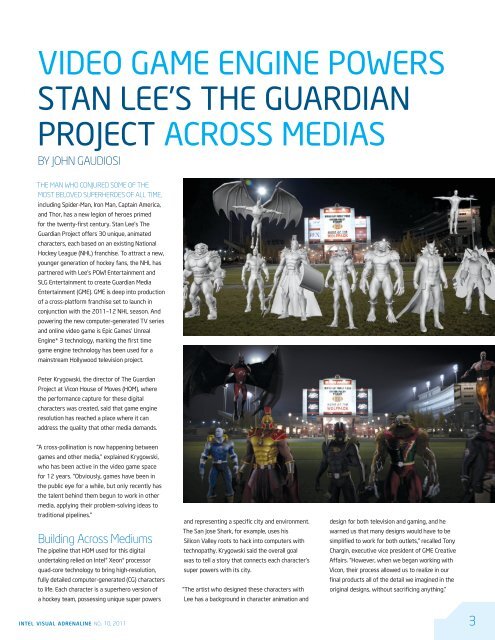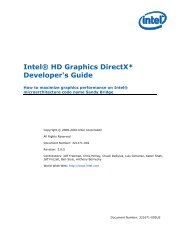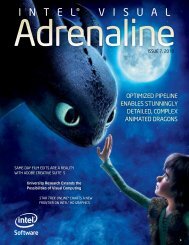Intel ® Visual
Intel ® Visual
Intel ® Visual
Create successful ePaper yourself
Turn your PDF publications into a flip-book with our unique Google optimized e-Paper software.
VIDEO GAME ENGINE POWERS<br />
STAN LEE’S THE GUARDIAN<br />
PROJECT ACROSS MEDIAS<br />
BY JOHN GAUDIOSI<br />
THE MAN WHO CONJURED SOME OF THE<br />
MOST BELOVED SUPERHEROES OF ALL TIME,<br />
including Spider-Man, Iron Man, Captain America,<br />
and Thor, has a new legion of heroes primed<br />
for the twenty-first century. Stan Lee’s The<br />
Guardian Project offers 30 unique, animated<br />
characters, each based on an existing National<br />
Hockey League (NHL) franchise. To attract a new,<br />
younger generation of hockey fans, the NHL has<br />
partnered with Lee’s POW! Entertainment and<br />
SLG Entertainment to create Guardian Media<br />
Entertainment (GME). GME is deep into production<br />
of a cross-platform franchise set to launch in<br />
conjunction with the 2011–12 NHL season. And<br />
powering the new computer-generated TV series<br />
and online video game is Epic Games’ Unreal<br />
Engine* 3 technology, marking the first time<br />
game engine technology has been used for a<br />
mainstream Hollywood television project.<br />
Peter Krygowski, the director of The Guardian<br />
Project at Vicon House of Moves (HOM), where<br />
the performance capture for these digital<br />
characters was created, said that game engine<br />
resolution has reached a place where it can<br />
address the quality that other media demands.<br />
“A cross-pollination is now happening between<br />
games and other media,” explained Krygowski,<br />
who has been active in the video game space<br />
for 12 years. “Obviously, games have been in<br />
the public eye for a while, but only recently has<br />
the talent behind them begun to work in other<br />
media, applying their problem-solving ideas to<br />
traditional pipelines.”<br />
Building Across Mediums<br />
The pipeline that HOM used for this digital<br />
undertaking relied on <strong>Intel</strong><strong>®</strong> Xeon<strong>®</strong> processor<br />
quad-core technology to bring high-resolution,<br />
fully detailed computer-generated (CG) characters<br />
to life. Each character is a superhero version of<br />
a hockey team, possessing unique super powers<br />
and representing a specific city and environment.<br />
The San Jose Shark, for example, uses his<br />
Silicon Valley roots to hack into computers with<br />
technopathy. Krygowski said the overall goal<br />
was to tell a story that connects each character’s<br />
super powers with its city.<br />
“The artist who designed these characters with<br />
Lee has a background in character animation and<br />
design for both television and gaming, and he<br />
warned us that many designs would have to be<br />
simplified to work for both outlets,” recalled Tony<br />
Chargin, executive vice president of GME Creative<br />
Affairs. “However, when we began working with<br />
Vicon, their process allowed us to realize in our<br />
final products all of the detail we imagined in the<br />
original designs, without sacrificing anything.”<br />
intel visual adrenaline no. 10, 2011 3













